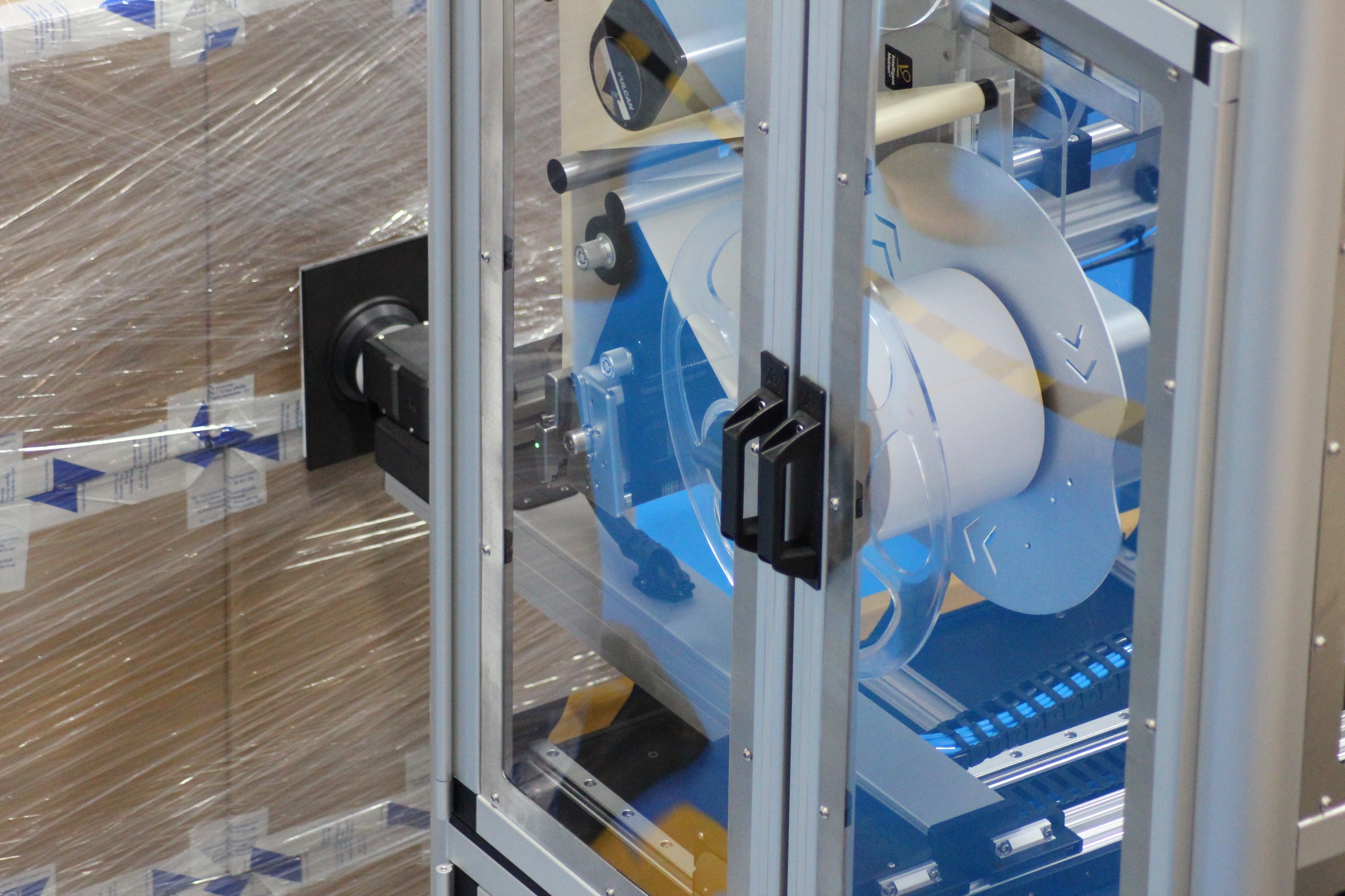What is automated pallet labelling?
Introduction
Pallet labelling simply put, is the automated application of the logistics labels at the end of the production process, allowing the pallet or logistics unit to be identified and tracked through the entire supply chain. Like all areas of a production line, it is an extremely important component within the production process, in particular to ensure complete traceability and to ensure that warehouses and logistics teams can scan the barcode adequately for identification and stock control.
Here we explore the different types of pallet labelling, why it is needed and how automated pallet labelling can hugely increase the productivity of a production process.

How does pallet labelling work?
Pallet labelling is also described as tertiary labelling. This usually follows a sequence of many primary coded items, with point of sale barcodes, being grouped together to create a secondary package or carton. This is labelled usually with an ITF14 or GS1-128 case label identifying the product and number of single items in the case. At the end of a production process these secondary cases are palletised to create a pallet or single logistics unit. The pallet is usually shrink-wrapped for stability and is then labelled, adhering to GS1 Standards.
Individual suppliers have some degree of artistic licence on the design of their pallet label with regards to the exact label contents, but it is crucial that appropriate GS1 Standards are checked and applied to the overall design. For pallet labelling in particular, a GS1 logistics label must be applied, containing a unique 18 digit SSCC barcode. Once the label has been designed to the required specification, these can then be printed via a labelling machine for manual or automatic application.
For manual application, this will require an operator to print the label from a desktop label machine, tear the label from the printer and apply it to the required faces of the pallet. Alternatively, factories can install an automated pallet labeller which uses print and apply technology. For automated pallet labelling, the label is printed and then usually applied via a mechanical labelling arm, in a repeatable, uniform position.
What is a GS1 pallet label?
GS1 UK is a not-for-profit organisation owned by its members. [1] GS1 develop and implement global supply chain standards to make it faster, cheaper and safer for its members to serve their customers, regardless of where they are in the world. [2]
A GS1 pallet label, or a GS1 logistics label is most commonly an A5 label (148mm x 210mm) which uses GS1-128 barcodes and provides all relevant information for each stage of the supply chain. On these labels, there should always be a Serial Shipping Container Code (SSCC), which is a unique 18 digit number for each pallet.
For more information on SSCC, please read our guide here.
The pallet label should be split out into 3 sections.
- Top section: This section is for the company name/logo and any other additional information the company sees as necessary.
- Middle section: This is where the SSCC number for the pallet should be displayed in human readable form. You will also find other information here that may be defined using the AI standards (Application Identifier). Please see our guide on SSCC for more information on AI standards.
- Lower section: This is where the GS1-128 barcodes are displayed. There are no limits to the amount of GS1-128 barcodes that can be shown on a pallet label. The SSCC should always be shown in the lowest barcode on the label.
How should these labels be positioned?
For each pallet, two labels should be affixed to adjacent sides of the unit; one for a short side and one for a long side of the pallet. GS1 states that “many pallets will be handled on automatic systems so it is recommended that the label should be applied on the right hand side of the permitted area for best use of scanning.” [3]
The position will depend on the size of the pallet. For units taller than 1000mm, the label should be placed so that the barcodes are no higher than 800mm and no lower than 400mm from the pallet base. For units lower than 1000mm, the label should be placed as high as possible but the barcode should be no higher than 800mm and no lower than 32mm from the base of the unit. For both, the label should be no closer than 50mm to a vertical edge.
What are the benefits of a pallet labeller?
For operations that require large amounts of pallet labelling may be better suited for automatic pallet labelling machines. Through print and apply technology, pallet labellers are able to print labels on demand and apply each label to adjacent sides of a pallet via a mechanical arm.
Pallet labelling machines are a strong alternative to manually applying labels. Whilst being able to print and apply labels to GS1 specifications, pallet labellers can print high volumes of units every hour, increasing overall productivity, and usually negating the need for the FLT to get on and off his vehicle to apply labels, which usually has an element of health and safety risk in a busy warehouse where FLT traffic is high. Automated labelling also means that labour can be allocated elsewhere within the operation, removes any human errors, and applies labels in a consistent, uniform way.
For a fully connected factory, a pallet labeller can be networked with the rest of the operation e.g. primary, secondary and tertiary coding and labelling equipment networked to a central database or WMS.
e.g. primary, secondary and tertiary coding and labelling equipment networked to a central database or WMS.

Can Clearmark help?
Clearmark Solutions has its own innovative pallet labeller, the ICE 9560PL. The 9560PL uses proven ICE Vulcan Print and Apply technology, providing maximum label visibility and product traceability on A5 labels set to a GS1 compliant specification. The ICE 9560PL can print on 100 pallets per hour*, and features barcode scanning, a dust-proof shutter and optional heater for atmospheric containment, ideal for challenging environments.
You can find more information on the ICE 9560 PL Pallet Labeller here, or you can watch a demonstration video of the Vector below.
[1] https://www.gs1uk.org/sites/de...
Related Articles
SSCC for pallet labelling

GS1-128 Data Embedded Barcodes

Get in touch
Looking to automate your pallet labelling? Get in touch with us today and one of our experts will be able to help!

